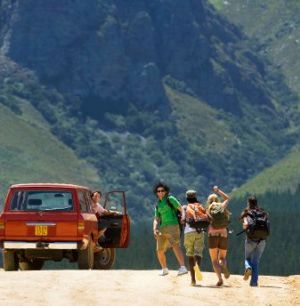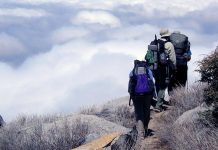Hiking is a wonderful way to enjoy the outdoors and explore everything that Mother Nature has to offer. But sometimes you just have to give in and call it a day if things aren’t going as planned. Nobody likes to turn around and head back to their campsite if they haven’t reached their goal, but safety should always be the number one concern when it comes to hiking.
It’s important that you stay hydrated while heading out on a hike. It’s often hard to predict how hard a hike might be and you might underestimate its difficulty. You need to make sure you have enough water with you at all times. If you start to get dehydrated you may suffer some symptoms such as muscle cramps, dizziness, nausea, and perhaps even heart palpitations.
 You can never have too much water with you. If you get any of these symptoms while hiking make sure you stop and drink some water.
You can never have too much water with you. If you get any of these symptoms while hiking make sure you stop and drink some water.
If you don’t have any left, then it’s time to pack it in and head back to your campsite as quick as you possibly can.
Another priority when taking a hike is clothing. Make sure you’re dressed properly for the physical conditions and the weather.
The weather can change drastically even on a short walk, especially if you’re in a high altitude. Storms and cold temperatures can appear before you know it, so it’s important to have something with you to keep you dry and warm. You need to keep your body temperature at the proper level when hiking.
If you end up getting soaked in the back country then it’s too late to think of clothing. You’ve already gone as far as you should go as being cold and wet could lead to hypothermia. If you’re out in the woods and a storm strikes you need to take cover wherever it’s safe. If you end up getting soaked head back to camp and if there’s any sunshine at all make sure you walk in it.
While hiking can often lead to some closeup encounters with beautiful animals such as deer, remember they’re in their natural habitat and you aren’t in yours. It can be tempting to get as close as possible to some types of animals, but you could scare them and you never know how they’re going to react.
In addition, if it’s a baby animal then there’s a good bet that the protective parents are somewhere in the vicinity too. Keep your eyes out for animals, especially bears, and if you suddenly find yourself surrounded by an unusual number of them of if they’re acting strangely, you might want to turn back.
You also need to keep on the beaten path as much as possible when hiking in the wilderness. Don’t stray too far from it or you may never find your way back to it. Marking the path is always a good idea if you’re going to be returning on the same route. You can use anything you can find to do this.
If you happen to get lost or lose the trail for any length of time, you can’t assume that you’re going to meet up with it again. You should always have some type of map, compass, and communication device when taking long hikes in the woods. If you get lost and you suddenly find the trail again, it’s a good idea to head back.
These are just a few of the things that will make your hike safer, but there are many other safety guidelines you should follow, such as taking an emergency kit and first aid kit with you.










